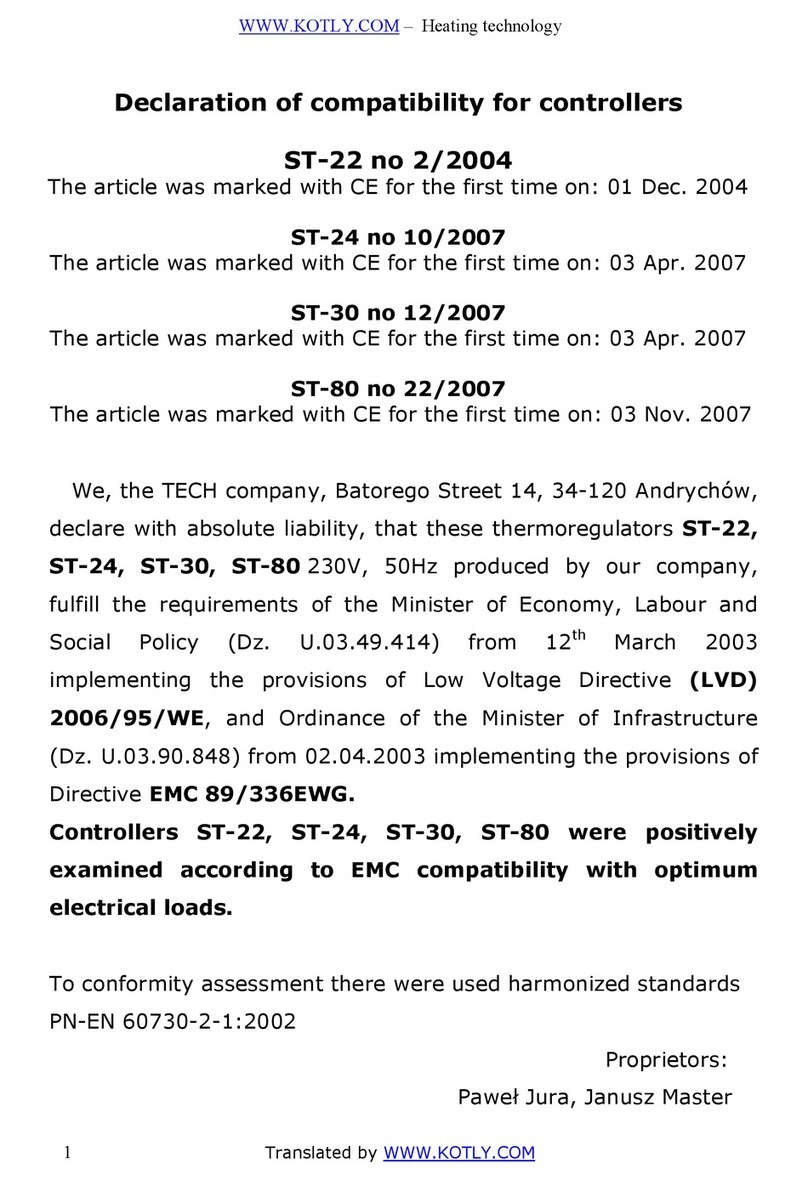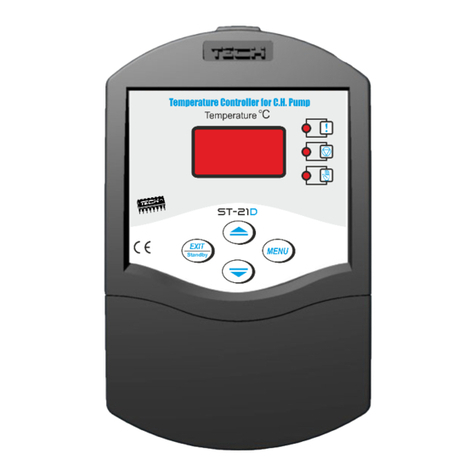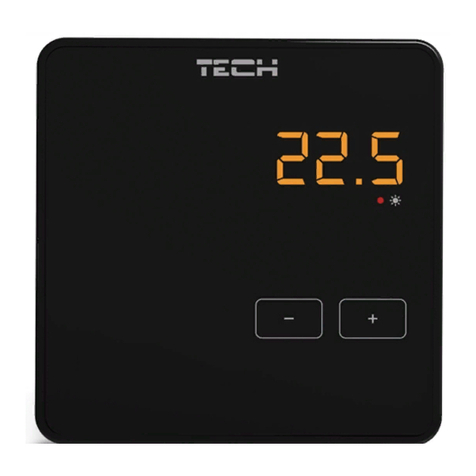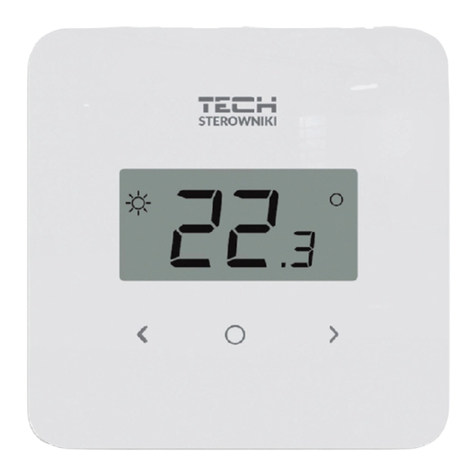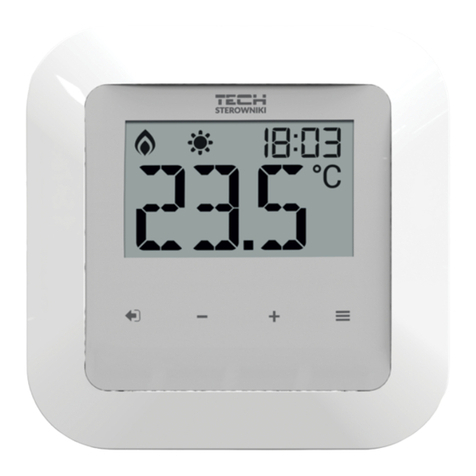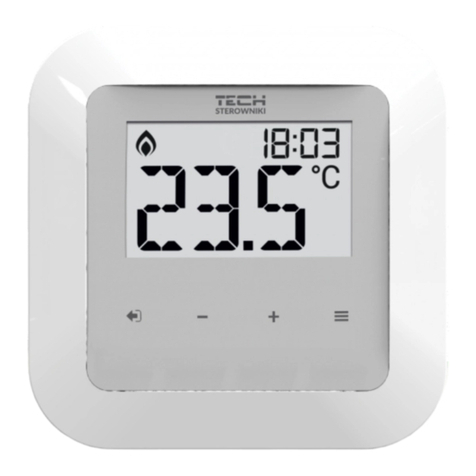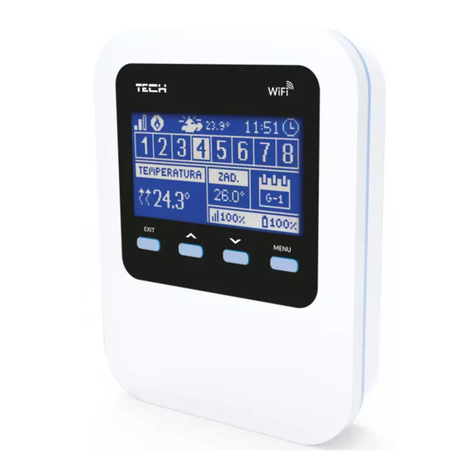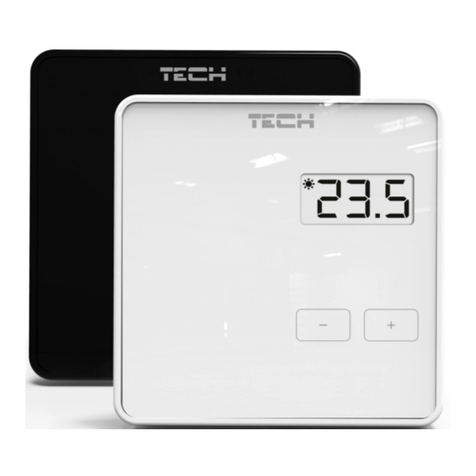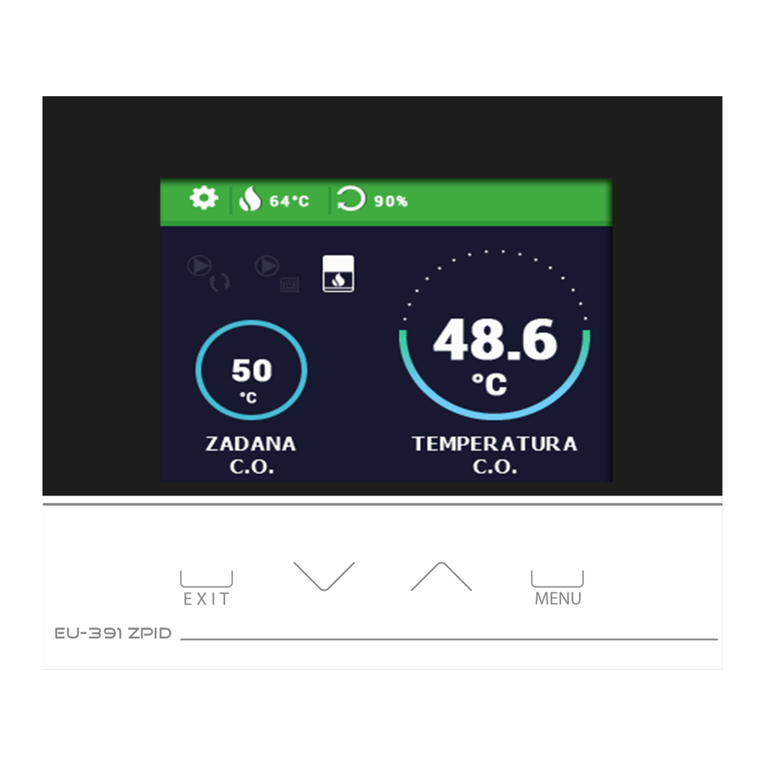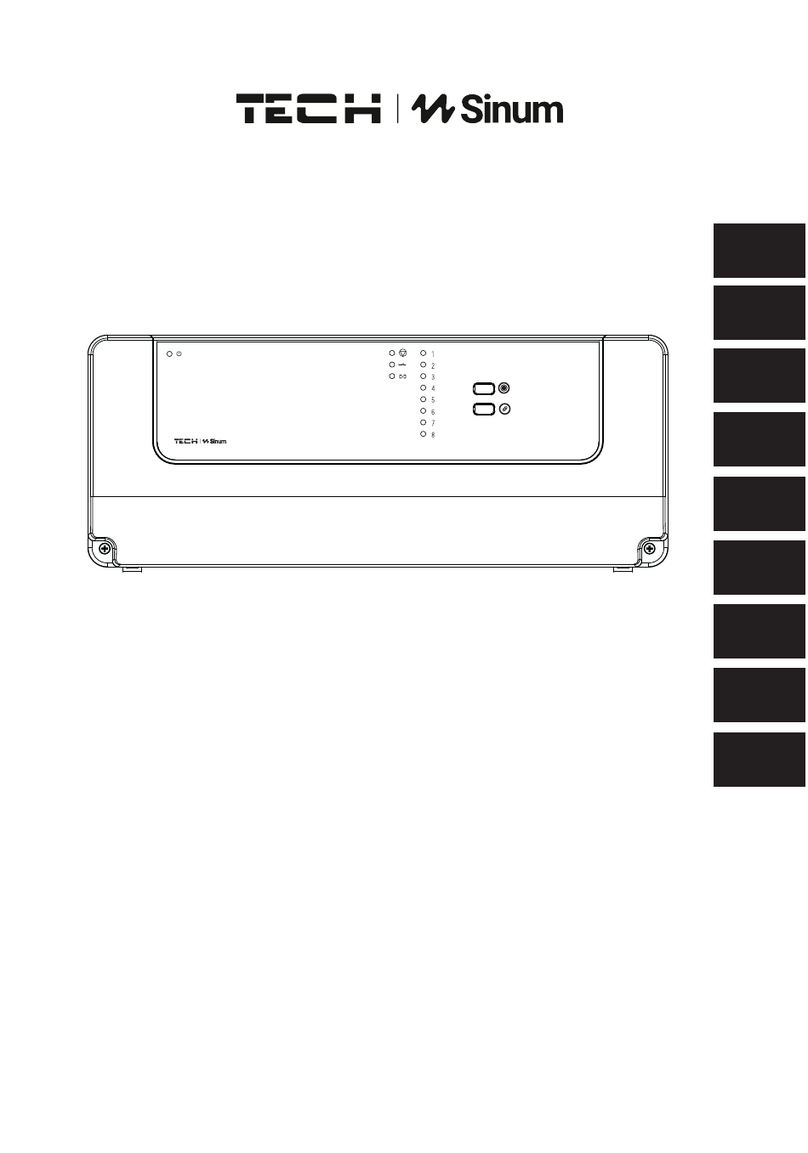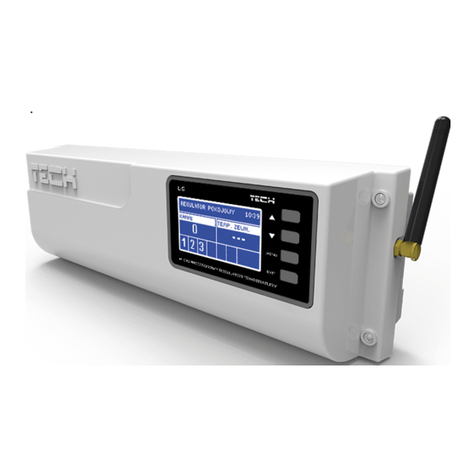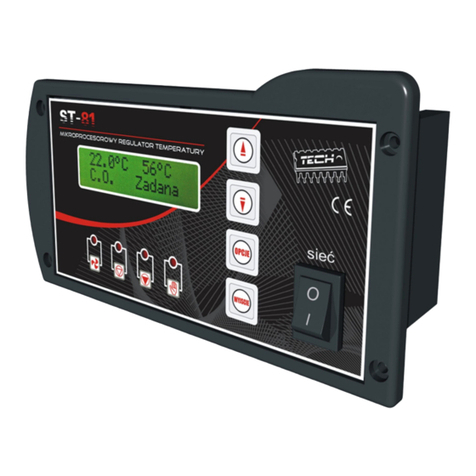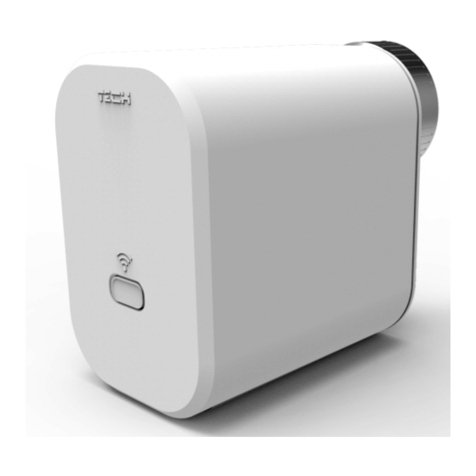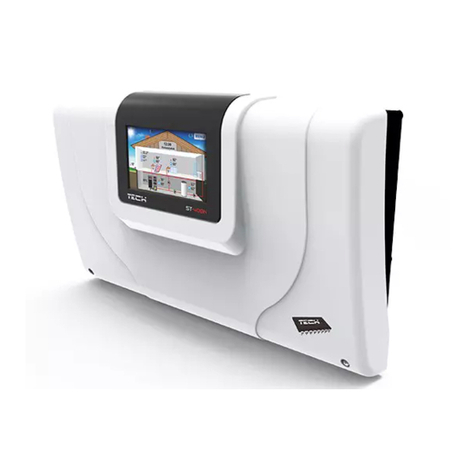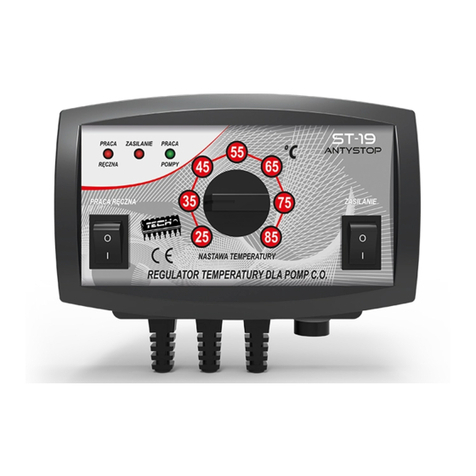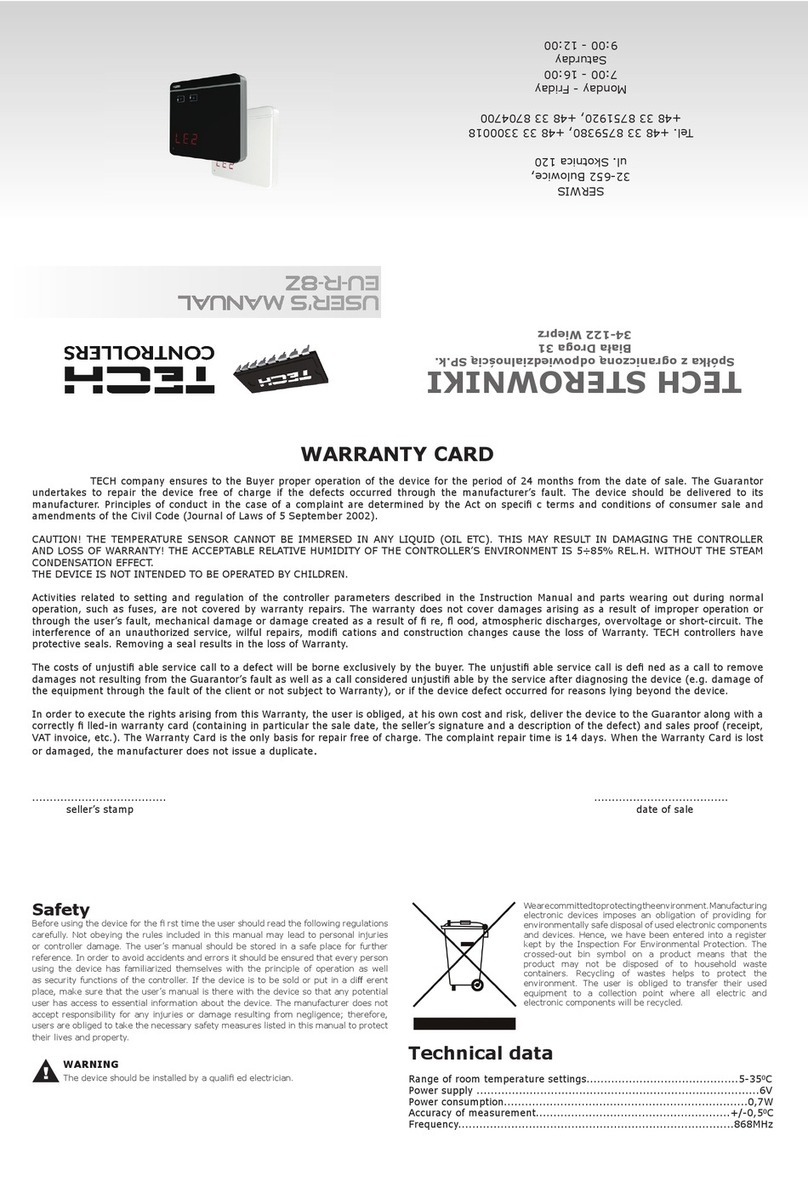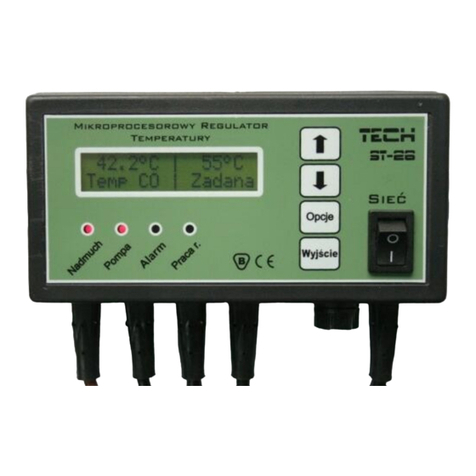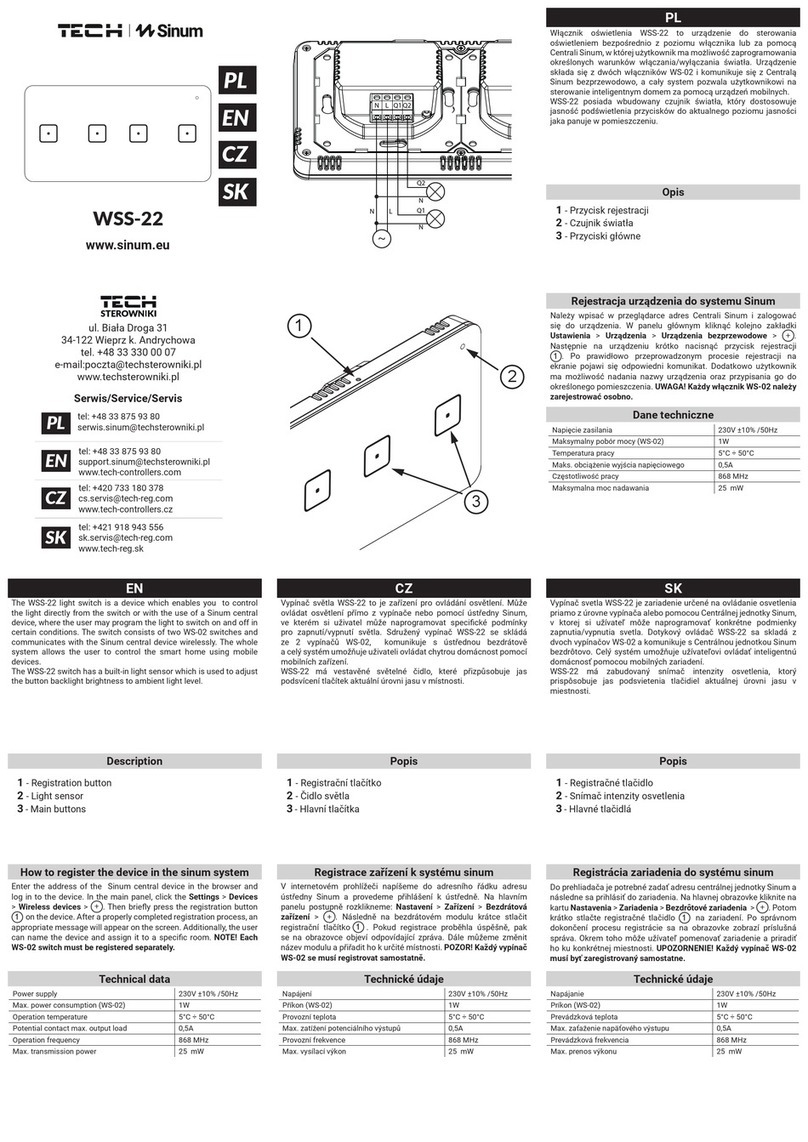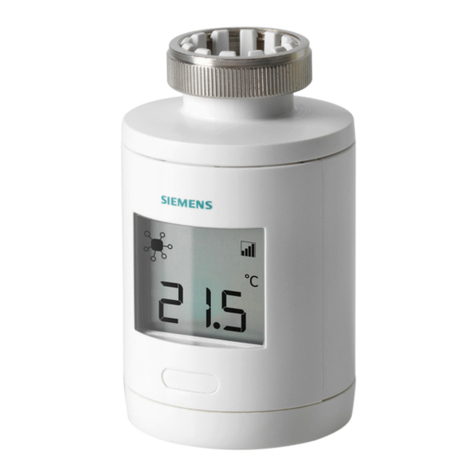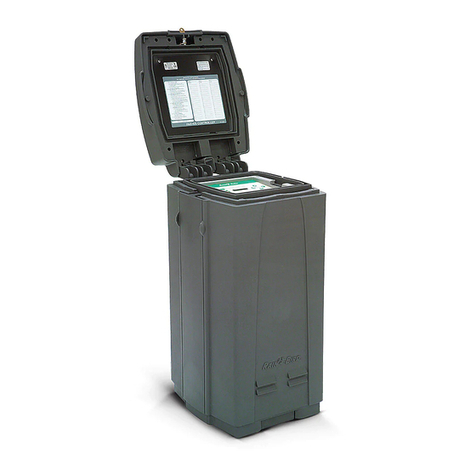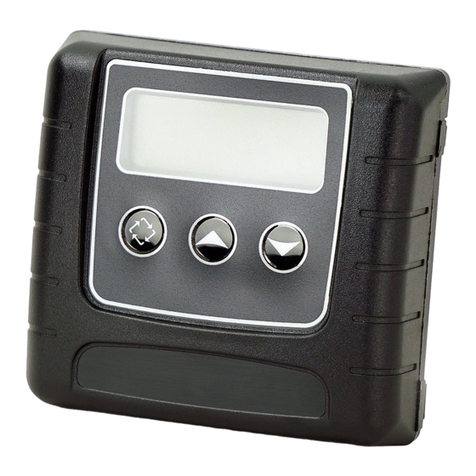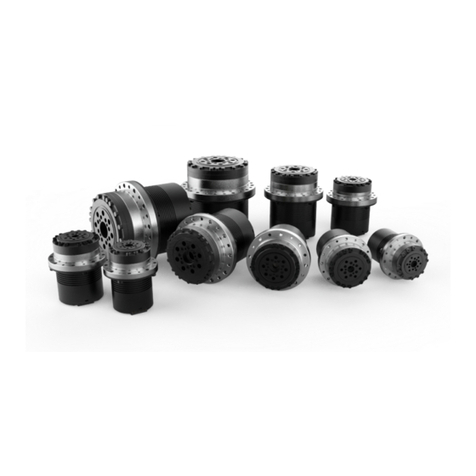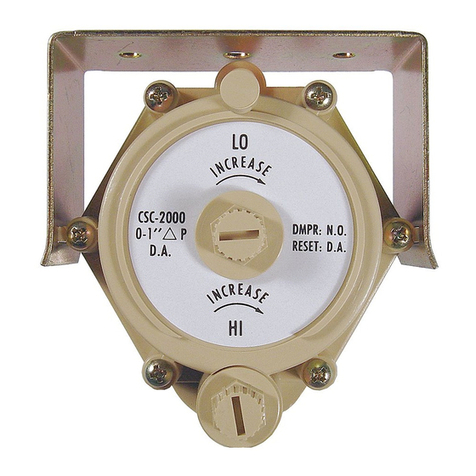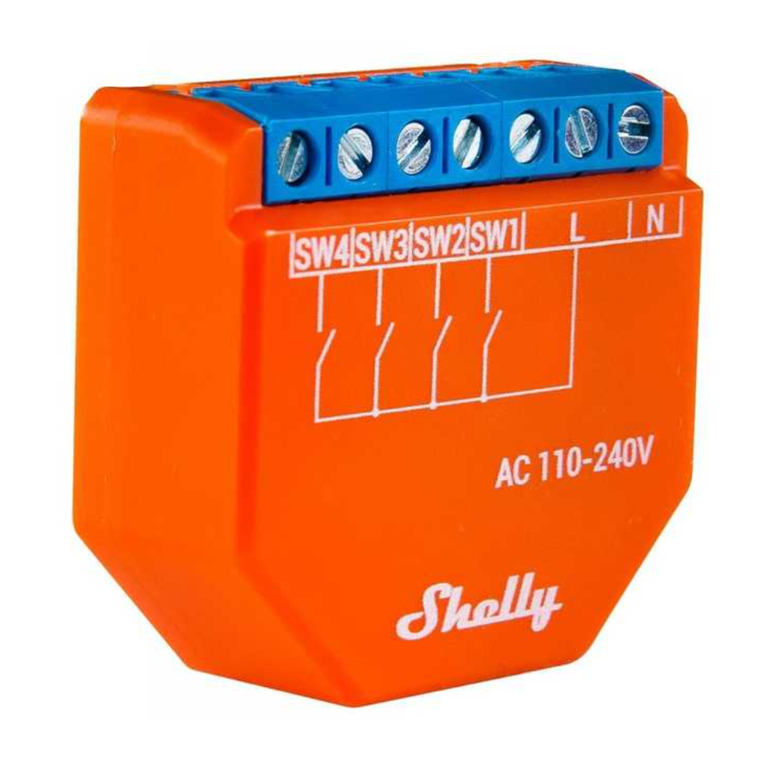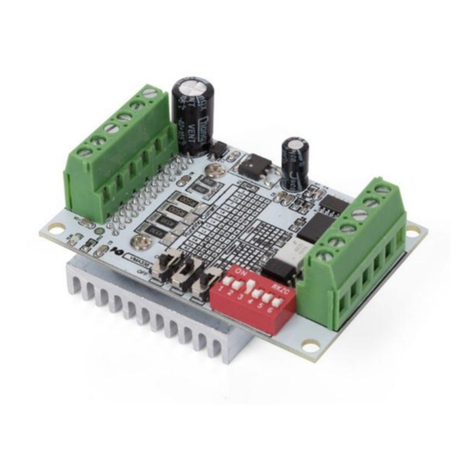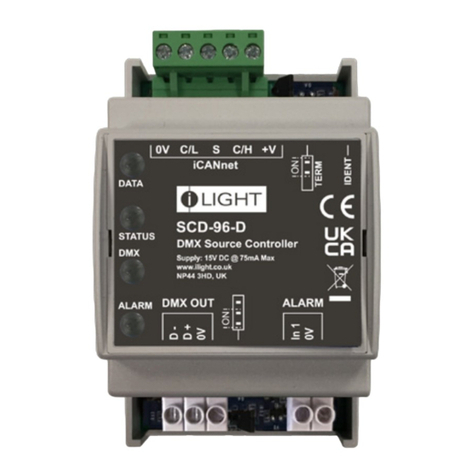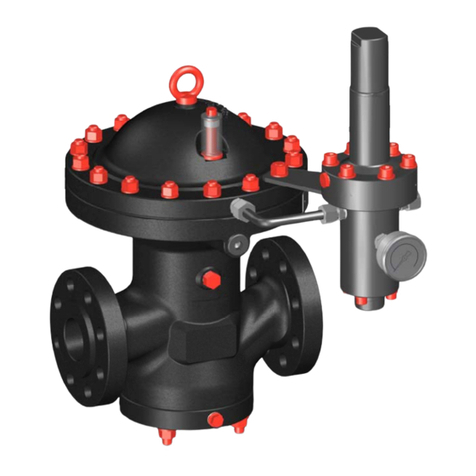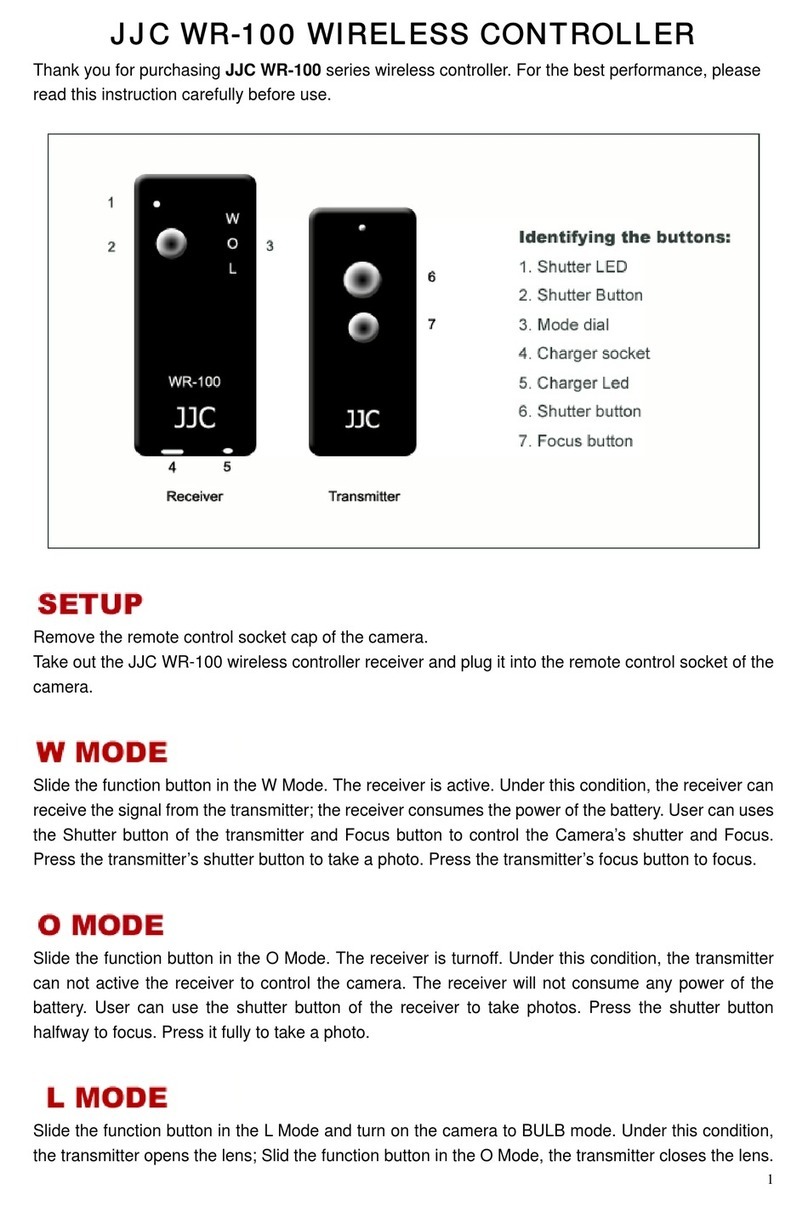TECH ST-402N PWM User manual

Tech
- 1 -
User’s manual
ST-402N PWM

ST-402N User's Manual v 1.0.3
- 2 -
I. Safety
Before using the device for the first time the user should read the following regulations carefully. Not
obeying the rules included in this manual may lead to personal injuries and device damage. The user's
manual should be stored in a safe place for further reference.
In order to avoid accidents and errors it should be ensured that every person using has familiarized
themselves with the principle of operation and security functions of the device. If the device is to be
sold or put in a different place, make sure that the user's manual is kept with the device so that any
potential user has access to essential information about the device. The manufacturer does not accept
responsibility for any injuries or damage resulting from negligence; therefore, users are obliged to take
the necessary safety measures listed in this manual to protect their lives and property.
WARNING
High voltage. Make sure the regulator is disconnected from the mains before perform-
ing any activities involving the power supply (plugging cables, installing the device
etc.).
The device should be installed by a qualified electrician.
Before starting the controller, the user should measure the earthing resistance of the
electric motors as well as the insulation resistance of the cables.
The regulator should not be operated by children.
NOTE
The controller may be damaged if struck by lightning. Make sure the plug is discon-
nected from the power supply during storms.
Any use other than that specified by the manufacturer is forbidden.
Before and during the heating season, the controller should be checked for the condition
of its cables. The user should also check if the controller is properly mounted and clean
it if dusty or dirty.
After the editing of this manual was completed on June 29, 2015, changes in products specified in the
manual may have taken place. The manufacturer reserves the right to change the information in
regards to products. The illustrations may contain additional equipment. The printing technology may
affect differences in shown colours.

Tech
- 3 -
II. Application
The ST-402N type temperature regulator is intended for the operation of solar collectors for various
system configurations. This device controls the operation of collector pumps (or a pump and a valve)
on the basis of the measurement of the solar panel temperatures and the accumulation tank (two
tanks) temperature. There is an option to connect an additional device: circulation pump, electric heater
or feeding the signal to the CH boiler in order to fire it up.
It is possible to control the circulation pump and feed the firing-up signal to the CH boiler directly
from the controller, while an additional signal relay is necessary to control the heater.
III. Principle Of operation
Description of the Control Panel of a Sample System
Opis panelu sterującego przykładowego układu
The regulator is controlled through the use of buttons. The user may enter the menu and confirm the
settings by pressing the Menu button. Using the Plus and Minus buttons, the user moves through the
menu's functions. In order to accept the selected menu item, the user should press the Menu button.
In order to proceed to the main screen (or the menu of a higher level), the user should use the Exit
button. Any setting may be changed in a similar manner.
Switching Valve
Switching Valve
Timer
Collector
Temperature
Operation Mode
Additional Device
Started
MENU
PLUS Button
MINUS Button
EXIT
Heat Container's
Temperature
Collector Cump
Collector
Temperature

ST-402N User's Manual v 1.0.3
- 4 -
IV. User Menu
IV.a) Home Page
During the regulator's standard operation, the Graphic Display shows the Homepage which displays
the diagram of the selected system and:
- Operation mode (or alarm type),
- Current hour,
- Collector's temperature,
- Current heat container temperature,
- The temperatures of all additional sensors, depending on the configuration.
The following graphic elements are displayed on the right hand side:
The Symbol of Active Operation Mode:
The Symbol of Active Additional
Device (Peripherals):
Automatic Operation Mode
Circulation Pump
Collector Defrosting Mode
Firing-up the Pellet Boiler
(voltage-free signal)
Holiday Mode
Heater
Collector Overheat (alarm mode)
Anti-Legionella
Sensor Damage (alarm mode)
If one of the sensors is damaged, an additional icon will flash as an indicator in the place of
the displayed temperature of the damaged sensor, informing the user about the sensor that is
disconnected or is damaged.
Additionally, the installation system diagram shows a pump symbol (it rotates when in operation) and/or
a valve symbol (indicating the current circulation path)

Tech
- 5 -
IV.b) Main Menu – Flowchart
Due to its multifunctional nature, the controller's menu is divided into the Main Menu and the Service
Menu.
The Main Menu is used to adjust the controller's basic options such as changing the operation modes,
timer settings, date settings, changing the language etc. The layout of parameters in the Main Menu is
shown by the flowchart below.
*Parameter visible if an additional device (i.e. a heater) is connected.
IV.c) Operation Mode
Using this function, the user selects the operation mode.
IV.c.1) Automatic Operation
The pump operates during the Automatic Operation mode if the minimum difference of temperatures
between the collector and the tank is reached (the difference between these temperatures when the
pump is activated is determined by the function "Solar Pump Activation Delta" in: SERVICE MENU >
Pumps > Solar Pump Activation Delta).
The pump will operate until the set temperature is reached (the set temperature is adjusted in:
SERVICE MENU > Accumulation Tank > Set Temperature) or until the difference of temperatures
between the collector and the tank reaches the deactivation delta threshold: SERVICE MENU > Pumps
> Solar Pump Deactivation Delta (in this case, the pump will be activated again when the temperature
on the collector increases above the tank's temperature by the Solar Pump Activation Delta). When the
pump is deactivated after reaching the set temperature, it will be activated again if the temperature
drops below the set value by the amount specified by the Tank's Hysteresis (the hysteresis value is
adjusted in: SERVICE MENU > Accumulation Tank > Tank Hysteresis).
IV.c.2) Collector Defrosting
Using this mode, the user may manually activate the collector's pump in order to melt the snow on the
solar panels. After activation, this mode is active throughout a period of time defined by the user and
then the controller returns to its automatic operation (the defrosting time is set in: SERVICE MENU>
Solar Collector > Defrosting Time). This function may be switched off manually after a shorter operation
time by selecting a different operation mode.
Main Menu
Operation Mode
Automatic Operation
Collector Defrosting
Holiday Mode
Anti-Legionella*
Manual Operation
Timer
Date
Ethernet Module
Activate
IP Address
Reset Module Password
Advanced Settings
Information
GSM Activate
Information
Statistics
Gain
Collector Overheat
Power Supply Failures
Backlight
Display Contrast
Language
Information
Factory Settings
Service Menu

ST-402N User's Manual v 1.0.3
- 6 -
IV.c.3) Holiday Mode
After the user activates Holiday Mode, the pump operates when one of the following conditions is met:
The collector's temperature increases to the overheat temperature value (SERVICE MENU> Solar
Collector > Overheat Temperature) reduced by the value of the parameter Delta Holiday (SERVICE
MENU> Solar Collector > Delta Holiday). When this condition is met, the pump is activated to cool down
the collector. The pump is deactivated after the temperature is reduced by 5°C.
If the collector's temperature is lower than the tank's temperature – the pump is activated to cool
down the tank and will operate until the collector's and the tank's temperatures are level.
IV.c.4) Anti-Legionella
This function is only active when an additional device is connected (found under the function Peripherals
in the Service Menu and then activated). Thermal disinfection involves increasing the temperature to
the required disinfection temperature in the tank – this reading is taken from the upper sensor in the
tank (in the case of using an optional sensor, the user should make sure that this sensor measures the
temperature in the upper part of the tank because this is the priority sensor for this function). This is
to eliminate the Legionella pneumophila bacteria that reduce the body's cell immunity. These bacteria
often multiply in tanks with stagnant hot water (at an optimum temperature of 35°C). After the user
activates this function, the tank heats up to the defined temperature (SERVICE MENU > Peripherals >
Heater > Anti-Legionella > Anti-Legionella Temperature) and maintains such a temperature for the
time of disinfection (SERVICE MENU > Peripherals > Heater > Anti-Legionella > Anti-Legionella Time)
and then returns to the regular operation mode.
From the moment of activating the disinfection, the temperature of disinfection needs to be reached in
no longer than the time defined by the user (SERVICE MENU > Peripherals > Heater > Anti-Legionella
> Maximum Anti-Legionella Time), otherwise this function is deactivated automatically.
IV.c.5) Manual Operation
Using this function, the user may manually (by pressing the ‘Menu’ button) activate and deactivate the
following to control the installation's equipment:
- Solar Pump,
- Second Solar Pump or Switching Valve,
- Peripherals - Additional Device (voltage-free contact e.g. for firing up the pellet boiler).
IV.d) Timer
Using this function, the user adjusts the current hour for regulator operation.
IV.e) Date
Using this function, the user adjusts the current date. The correct adjustment of date and hour is
necessary to calculate energy in a proper manner.
IV.f) Ethernet Module
NOTE
Control of this type is possible after purchasing and connecting an additional ST-500 control module
(which is not added to the controller as a standard).
The Ethernet Module is a device for enabling remote control over the collector's operation via
the Internet or a local network. On the home computer screen, the user controls the status of all the
solar installation devices and the operation of each device is presented in the form of an animation.
After activating the Internet module and selecting the DHCP option, the controller automatically
downloads the following parameters from the local network: IP Address, IP Mask, Gateway Address and
DNS Address. In the case of any problems with downloading the network parameters, it is possible to
adjust these parameters manually. The method of obtaining the local network's parameters is described
in the manual for the Internet Module.
The function Reset Module Password may be used when the user changed the factory user's
password to his own password on the login page. When the new password is lost, it is possible to return
to the factory password after resetting the module password.

Tech
- 7 -
IV.g) GSM Module
NOTE
Control of this type is possible after purchasing and connecting an additional ST-65 control module
(which is not added to the controller as a standard).
The GSM module is an optional device designed to work in tandem with the collector's controller,
enabling remote control over the collector operation with the use of a mobile phone. The user is notified
with a text message about each alarm of the solar installation's controller and they receive a return
message with information on the current temperature of all sensors by sending an appropriate text
message at any time.
The ST-65 module may also operate independently of the collector. It has two inputs with
temperature sensors, one contact input to be used in any configuration (detecting closing/opening of
contacts) and one controlled output (e.g. possibility to connect an additional contactor to control any
electrical circuit).
When any temperature sensor reaches the set maximum or minimum temperature, the module
automatically sends a text message with such information. It is similar in the case of a closing or
opening of the contact input which may be used e.g. for the simple protection of property.
IV.h) Statistics
The parameters in this submenu allow the user to monitor the current conditions of the controller's
operation:
IV.h.1) Gain
This parameter allows the user to monitor the current values of gained energy in certain sections of
time: daily, weekly, monthly, annual and temporary.
CAUTION
Statistical data displayed in the controller is approximate – it is used only to determine the approximate
values of gained energy.
IV.h.2) Collector Overheat
After the user enters this submenu, the controller's display will show the list of the collector's overheats
(too high temperature of the collector's sensor). The user may see:
The date when the overheating occurred.
The hour.
The duration.
The reading from the collector's sensor.
IV.h.3) Power Supply Failures
After the user enters this submenu, the controller's display will show the list of power supply failures
registered by the controller. The user may see:
Date of occurrence.
Hour of occurrence.
Duration of occurrence.
IV.i) Backlight
This parameter regulates the display's brightness. This change takes place after a dozen or so seconds
of idleness.
IV.j) Display Contrast
This parameter regulates the display's contrast.
IV.k) Language
The user may select the controller's language version.
IV.l) Information
When the user selects this option, a screen with the controller's manufacturer logo and the current

ST-402N User's Manual v 1.0.3
- 8 -
program version appears.
IV.m) Factory Settings
This function allows the user to load factory settings previously recorded in the service menu.
V. Service Menu
In order to enter the service settings, the user should select the SERVICE MENU option and then select
code 0112 using the Plus and Minus buttons and confirm it by pressing the Menu button. In order to
return to the display's main view (exit the service menu), the user should use the Exit button by
pressing it several times or waiting for approx. 30 seconds (the device will then automatically leave the
service mode).
The flowchart of the Service Menu is given below.
The ST-402N controller is adapted to operate various heating installations. When the
installation's scheme is changed this may lead to the appearance of additional functions in the
controller's service menu – marked with an asterisk (*) in the following flowchart.

Tech
- 9 -
*Parameters available only in certain installation schemes.
**Parameters unavailable if certain schemes are selected.
Service Menu
Scheme Selection
Accumulation Tank
Set Temperature
Maximum Temperature of Tank 1
Tank Hysteresis
Minimum Temperature of Tank 1
Cooling Down to Set Value
Holiday Delta
Valve Hysteresis*
Set Temperature of Tank 2*
Maximum Temperature of Tank 2*
Hysteresis of Tank 2*
Operation Algorithm*
Tank Reheating Priority*
Solar Collector
Overheat Temperature
Minimum Reheating Temperature
Alarm Hysteresis
Defrosting Time
Anti-Freeze Temperature
Collector Delta*
Heat receiver*
Receiver Maximum Temperature
Receiver Activation Temperature
Heat Receiver Hysteresis
Pumps
Regulated Revolutions
Collector Maximum Temperature
Solar Pump Deactivation Delta
Solar Pump Activation Delta
Gear Coefficient
Solar Pump Operating Minimum
Solar Pump Operating Maximum
Circulation Sampling
Oscillation Charging*
Oscillation Pause*
Maximum Heating Time Z2*
Deactivation Delta of Pump 2*
Activation Delta of Pump 2*
Peripherals **
None
Circulation Pump
Pellet Boiler Pump
Heater
DHW Cooling**
Contact Not Consistent with Pump
Contact Consistent with Pump
Calculation of Energy
Flow
Type of Agent
Glycol Solution
Calibration
Installation's Options*
Alarm Sound
Factory Settings

ST-402N User's Manual v 1.0.3
- 10 -
V.a) Installation Scheme
In order for the solar installation to operate correctly, it is necessary to properly select the appropriate
installation scheme (SERVICE MENU > INSTALLATION SCHEME), as well as to adequately configure the
additional options of the selected system.
CAUTION
During the selection of the installation scheme, the number of a given sensor is found near the values
of the sensors' temperatures. Relevant sensors should be connected to the relevant sensor slot
according to these numbers (in order from the left):
(1) – Collector Sensor (PT1000), (2) – Container Sensor (PT1000),
(3) - Additional Sensor 1 (PT1000), (4) – Additional Sensor 2 (PT1000).
V.a.1) Scheme 1/17 - Basic
Installation 1/17 Operates:
The Collector Pump.
The Accumulation Tank.
One direction of the collectors' location.
Additional peripherals.
Installation Sensors:
The Collector's sensor.
The Accumulation Tank's sensor.
V.a.2) Scheme 2/17 –One Tank - Order
Installation 2/17 Operates:
The Collector Pump.
The Switching Valve (top-bottom).
The Accumulation Tank with top and bottom circulation.
One direction of the collectors' location.
Additional peripherals.
Installation Sensors:
The collector's sensor,
The two sensors of the Accumulation Tank – top and bottom.
Additional Parameters to be Adjusted:
Valve Hysteresis.
Oscillation charging.
The oscillation pause time.
Maximum heating time Z2.
V.a.3) Scheme 3/17 –Two Collectors, Two Pumps
Installation 3/17 Operates:
The two Collector Pumps (the pumps operate independently,
each according to its own circulation).
The Accumulation Tank.
The two directions of the collectors' location.
Additional peripherals.
Installation Sensors:
The two collector sensors.
The Accumulation Tank's sensor.
Note:
Setting the Solar Collector option (SERVICE MENU > SOLAR COLLECTOR) applies equally to collectors
situated in both directions.

Tech
- 11 -
Additional Parameters to be Adjusted:
Deactivation delta of pump 2.
Activation delta of pump 2.
V.a.4) Scheme 4/17 –Two Collectors, Valve
Installation 4/17 Operates:
The Collector Pump.
The valve switching between the collectors
The Accumulation Tank.
The two directions of the collectors' location.
Additional peripherals.
Installation Sensors:
The two collector sensors.
The Accumulation Tank's sensor.
Additional Parameters to be Adjusted:
Collector delta.
V.a.5) Scheme 5/17 –Reheating with Boiler
Installation 5/17 Operates:
The Collector Pump.
The Auxiliary Pump – tank-boiler (Pump 2).
The Accumulation Tank with top and bottom circulation.
One direction of the collectors' location.
Additional peripherals (not possible to cool down using the
DHW pump).
Installation Sensors:
The collector's sensor.
The two sensors of the Accumulation Tank – top and bottom,
The boiler temperature sensor.
Additional Parameters to be Adjusted (additional submenu in the
service menu):
Installation's options: reheating activation delta, from hour..., to hour..., energy release,
energy release threshold, release hysteresis, release solar pump.
V.a.6) Scheme 6/17 –Two Tanks, Valve
Installation 6/17 Operates:
The Collector Pump.
The valve switching between the tanks.
The two accumulative tanks.
One direction of the collectors' location.
Additional peripherals.
Installation Sensors:
The Collector's sensor.
The Accumulation Tank sensors.
Additional Parameters to be Adjusted:
The set temperature of tank 2.
The maximum temperature of tank 2.
Hysteresis of tank 2.
Oscillation charging.
The oscillation pause time.
Maximum heating time Z2.
Valve Hysteresis.

ST-402N User's Manual v 1.0.3
- 12 -
V.a.7) Scheme 7/17 –Two Tanks, Two Pumps
Installation 7/17 Operates:
The two collector pumps.
The two accumulative tanks.
One direction of the collectors' location.
Additional peripherals.
Installation Sensors:
The collector's sensor.
The Accumulation Tank sensors.
Additional Parameters to be Adjusted:
Valve Hysteresis.
The set temperature of tank 2.
The maximum temperature of tank 2.
Hysteresis of tank 2.
Operation algorithm.
Oscillation charging.
The oscillation pause time.
Maximum heating time Z2.
Deactivation delta of pump 2.
Activation delta of pump 2.
V.a.8) Scheme 8/17 –Two Tanks - Order
Installation 8/17 Operates:
The Collector Pump.
The second tank's pump.
Tank 1 with top and bottom circulation.
Tank 2.
One direction of the collectors' location.
Additional peripherals (not possible to cool down using the
DHW pump).
Installation Sensors:
The collector's sensor.
The two sensors of the main accumulation tank – top
and bottom.
The sensor of the additional accumulation tank.
Additional Parameters to be Adjusted:
The set temperature of tank 2.
The maximum temperature of tank 2.
Hysteresis of tank 2.
Operation Algorithm.
Deactivation delta of pump 2.
Activation delta of pump 2.
V.a.9) Scheme 9/17 –Heat Exchanger
Installation 9/17 Operates:
The Collector Pump.
The switching valve between the tank and the exchanger.
The Accumulation Tank.
The Heat Exchanger (heat Receiver).
One direction of the collectors' location.
Additional peripherals.
Installation Sensors:
The collector's sensor.
The Accumulation Tank's sensor.
The Heat Exchanger sensor.

Tech
- 13 -
This installation, apart from the accumulation tank, also has a heat receiver (e.g. a swimming
pool or a CH installation), the task of which is to release rather than collect thermal energy.
Additional Parameters to be Adjusted:
Valve hysteresis.
The set temperature of tank 2.
The maximum temperature of tank 2.
Hysteresis of tank 2.
Oscillation charging.
The oscillation pause time.
The maximum heating time Z2.
Tank reheating priority.
V.a.10) Scheme 10/17 –Double Function Furnace
Installation 10/17 Operates:
The Collector Pump.
The valve switching to the two-state reheating furnace.
The Accumulation Tank with top and bottom circulation.
The double function furnace (reheating the output from
the Controller).
One direction of the collectors' location.
Additional peripherals.
Installation Sensors:
The collector's sensor.
The two sensors of the Accumulation Tank – top and
bottom.
This installation works with a double function furnace which
reheats the circulation. If the tank's temperature is too low, the valve switches to the furnace.
Additional Parameters to be Adjusted (additional submenu in the service menu):
Installation's Options: reheating deactivation.
V.a.11) Scheme 11/17 –Reheating the CH Return
Installation 11/17 Operates:
The Collector Pump.
The switching valve between the direct flow to the boiler
and flow through the tank.
The Accumulation Tank with top and bottom circulation.
The boiler's return circulation.
One direction of the collectors' location.
Additional peripherals (not possible to cool down via use
of the DHW Pump).
Installation Sensors:
The collector's sensor.
The two sensors of the Accumulation Tank - top and
bottom.
The boiler's return sensor.
This installation is equipped with a valve which, in the case of excess hot water in the tank, switches
the circulation to the boiler's return circulation in order to reheat it ( as well as release the excessive
heat) which will result in solid fuel savings.
Additional Parameters to be Adjusted (additional submenu in the service menu):
Installation's options: energy release threshold, release hysteresis, activation delta,
deactivation delta.

ST-402N User's Manual v 1.0.3
- 14 -
V.a.12) Scheme 12/17 –Two Collectors, Two Pumps, Tank and Additional Heat
Receiver
Installation 12/17 Operates:
The two Collector Pumps (the pumps operate
independently, each according to its own circulation).
The Accumulation Tank with bottom circulation.
The two directions of the collectors' location.
The Additional Heat Receiver.
The Switching Valve from the main circulation to the
additional receiver.
Installation Sensors:
The two Collector Sensors,
The Accumulation Tank's sensor.
The Additional Receiver's sensor.
Note:
It may appear that it is not possible to connect and select an additional device - the submenu Peripherals
is hidden in the controller's service menu. The switching valve operating the additional receiver is
connected instead of the peripherals.
Additional Parameters to be Adjusted:
Deactivation delta of pump 2.
Activation delta of pump 2.
V.a.13) Scheme 13/17 –Two Collectors, Pump, Valve, Tank and Additional Tank
Connected in Series
Installation 13/17 Operates:
The Collector Pump.
The Switching Valve.
The Accumulation Tank – solar with bottom circulation.
The Second Tank (heated with an additional heat source
e.g. the CH Boiler).
One direction of the collectors' location.
Additional peripherals (not possible to cool down using the
DHW pump).
Installation Sensors:
The collector's sensor.
The two sensors of the Accumulation Tank.
The sensor of the second tank.
This installation allows the user to control which tank is to be
used to collect hot water for the facility (the regulator selects the tank with the higher temperature).
In periods of poor insulation (i.e. the winter period), water is taken from the second tank (heated with
an additional heat source, e.g. the CH Boiler). On the other hand, water from the Solar Tank heated
by the solar installation reaches the input of the second tank as cold water.
Additional Parameters to be Adjusted:
Valve hysteresis.

Tech
- 15 -
V.a.14) Scheme 14/17 –Reheating the CH Return
Installation 14/17 Operates:
The Collector Pump.
The switching valve between the direct flow to the boiler
and flow through the tank.
The Accumulation Tank – solar with top and bottom
circulation.
The second tank (heated with an additional heat source
e.g. the CH Boiler).
One direction of the collectors' location.
Pump of tank 2 – the Mixing Pump.
Installation Sensors:
The collector's sensor.
The two sensors of the Accumulation Tank.
Sensor of the second tank.
This installation is able to independently control from which tank it collects hot water for the
facility (the regulator selects the tank with the higher temperature). In periods of large insulation,
temperature in the Solar Tank may be high and it may be transferred to the second tank and thus may
be used to heat more water than only that in the Solar Tank.
Note: Not possible to connect and select an additional device - the submenu Peripherals is hidden in
the controller's service menu. The switching valve operating the additional receiver is connected instead
of the peripherals.
Additional parameters to be adjusted:
Valve hysteresis.
Operation algorithm.
Deactivation delta of pump 2.
Activation delta of pump 2.
V.a.15) Scheme 15/17
Installation 15/17 Operates:
The Collector Pump.
The Switching Valve.
The Accumulation Tank - Solar.
The second tank (heated with an additional heat source
e.g. the CH Boiler).
One direction of the collectors' location.
Additional peripherals.
Installation Sensors:
The collector's sensor.
The two sensors of the Accumulation Tank.
Sensor of the second tank.
This installation is able to control which tank it collects hot
water from for the facility – it allows the user to switch valve to water intake from whichever tank has
the warmer water. In periods of poor insulation (i.e. the winter period), water is taken from the second
tank (heated with an additional heat source, e.g. the CH Boiler). On the other hand, water from the
solar tank heated by the solar installation reaches the input of the second tank as cold water.

ST-402N User's Manual v 1.0.3
- 16 -
V.a.16) Scheme 16/17
Installation 15/17 Operates:
The Collector Pump.
The Switching Valve.
The Accumulation Tank - Solar.
One direction of the collectors' location.
Additional peripherals.
Installation Sensors:
The collector's sensor.
The two sensors of the Accumulation Tank.
Valve sensor.
This installation allows the user to control the valve of the
CH installation return to the accumulation tank. The valve
switches the circulation from the top part of the tank to the bottom part.
Additional parameters to be adjusted:
Valve delta.
V.a.17) Scheme 17/17
Installation 17/17 Operates:
The Collector Pump.
The Pump Tank – Receiver.
The Accumulation Tank - Solar.
Heat Receiver.
One direction of the collectors' location.
Additional peripherals.
Installation Sensors:
The collector's sensor.
The two sensors of the Accumulation Tank.
Heat Receiver sensor.
Additional Parameters to be Adjusted (additional submenu in the service menu):
Heat Receiver: receiver maximum temperature, receiver activation temperature, heat receiver
hysteresis.
V.b) Accumulation Tank
This menu allows the user to adjust all parameters related to the tank (heat container).
V.b.1) Set Temperature
This function is used to adjust the set temperature in the container which leads to the deactivation of
the Collector Pump.
V.b.2) Maximum Temperature of Tank 1
Using this option, the user may declare the maximum acceptable safe temperature value to which the
tank is allowed to heat in the case of Collector Overheat.
If the collector reaches its alarm temperature (Overheat), the pump is activated automatically
in order to cool down the heated collector, regardless of the set temperature. The pump operates until
reaching the Tank's Maximum Temperature or until the collector's temperature drops by the value of
the Alarm Hysteresis (see: SERVICE MENU > Solar Collector> Alarm Hysteresis)
V.b.3) Minimum Temperature of Tank 1
Using this parameter, the user may declare the minimum acceptable temperature value to which the
tank is allowed to cool. Below this temperature, the pump does not activate in the Collector Defrosting
mode.

Tech
- 17 -
V.b.4) Tank Hysteresis
Using this function, the user declares the tank hysteresis value. If the tank reaches the set temperature
and the pump is deactivated, it will be activated again after the tank's temperature drops below the set
value by the value of this hysteresis.
V.b.5) Cooling Down to Set Value
When the collector reaches the overheat temperature, the pump is activated in emergency mode to
cool it down. In this case, the tank receives heating until exceeding the set temperature (up to the
maximum temperature). To prevent the accumulation of water which is too hot in the container, the
Cooling Down to Set Value function should be started. After activating this option, when the collector's
temperature drops below that of the container, the pump is activated in order to cool down the tank
until it reaches the set temperature.
V.b.6) Delta Holiday
This function is active only in the Holiday Operating mode. This parameter determines how many °C
before reaching the collector overheat temperature the pump is activated in order to cool it down. The
pump is deactivated after the collector's temperature is reduced by at least 5°C.
V.b.7) Valve Hysteresis
Option active only in the case of setting the installation scheme number: 2, 6, 9, 13 and 14.
This function determines the value by which the temperature needs to change so that the valve
is switched again.
In the case of scheme 2: the tank first reheats in the top part of the tank (where the inlet of hot utility
water is located). After this part of the tank is reheated, the valve switches the circulation to the second
part of the tank. The valve is activated again after the priority part of the tank is cooled down by the
value of valve hysteresis (this is the difference in temperatures of both parts of the tank).
In the case of scheme 6: the setting relates to valve control when cooling the Collector down in the
Summer Mode or Alarm Mode, as well as when defrosting. The valve hysteresis determines the
difference in temperatures between the tanks when the valve switches to the opposite tank.
In the case of scheme 9: when the set temperature of the first tank is reached, the valve switches the
power supply to the Heat Receiver's circulation. The valve is activated again after the first tank is cooled
down by the value of valve hysteresis (this is the difference in temperatures of both tanks).
In the case of schemes 13 and 14: the regulator controls the switching valve in the installation's model
– water from the warmer tank is directed to the facility. The difference in temperatures on tanks is
detected automatically, and if this difference reaches the value of the valve's delta, then the valve
switches to water intake from the warmer tank.
V.b.8) Set Temperature of Tank 2
Option active only in the case of setting the installation scheme number: 6, 7, 8 and 9.
This function determines the set temperature of tank 2 which leads to the deactivation of the
Collector Pump (schemes 6 and 9) or the pump of tank 2 (schemes 7 and 8).
V.b.9) Maximum Temperature of Tank 2
Option active only in the case of setting the installation scheme number: 6, 7, 8 and 9.
Using this option, the user may declare the maximum acceptable safe temperature value to which
the second tank is allowed to heat in the case of Collector Overheating.
V.b.10) Hysteresis of Tank 2
Option active only in the case of setting the installation scheme number: 6, 7, 8 and 9.
The pump is deactivated after reaching its set temperature. The pump is activated again after
the tank's temperature drops below the set value by the value of hysteresis of tank 2.
V.b.11) Operation Algorithm
Option active only in the case of setting the installation scheme number: 7, 8 and 14.
Using this option, the user selects the pump operation mode. The pumps may operate in the

ST-402N User's Manual v 1.0.3
- 18 -
following modes:
a) Priority of Tank 1 – first, tank 1 is heated (only pump 1 operates), after the set temperature
is reached, pump 2 is activated and reheats tank 2.
b) Parallel Operation – the pumps operate independently of one another, each within its own
range (according to the settings) and both tanks are heated at the same time.
V.b.12) Tank Reheating Priority
Option active only in the case of setting the installation scheme number: 9.
After the user marks this function, the tank's set temperature is treated as a priority – the valve
does not switch to the circulation with the heat receiver until the tank's set temperature is reached.
The function of oscillation loading is not taken into account in this situation.
V.c) Solar Collector
This menu allows the user to adjust all parameters related to the Solar Collector.
V.c.1) Overheat Temperature
This is the Solar Collector's acceptable alarm temperature at which the pump is forced to activate in
order to cool down the solar panels. The discharge of warm water will take place regardless of the
tank's set temperature. The pump will operate until its temperature drops below the alarm temperature
by the Alarm Hysteresis Value (Service Settings > Solar Collector > Alarm Hysteresis) or until the tank
reaches the maximum acceptable temperature (Service Settings > Accumulation Tank > Maximum
Temperature)
V.c.2) Minimum Reheating Temperature
This is the collector's threshold temperature. If the temperature within the collector is higher and is
dropping after reaching the minimum reheating temperature, the pump is deactivated. On the other
hand, when the temperature on the collector is below this limit and is increasing - the pump is activated
after reaching the minimum reheating temperature plus hysteresis - 3°C. The threshold reheating
temperature is not active in the emergency mode, manual operation or collector defrosting.
V.c.3) Anti-Freeze Temperature
Due to the different freezing temperatures of the liquid in the solar installation, the Anti-Freeze
Temperature was introduced. This parameter determines the minimum safe temperature when the
glycol liquid does not freeze (temperature measured on the collector). In the case of a significant drop
in the collector's temperature (to the value of this parameter), the pump is activated and operates
continuously until the collector is heated to a safe temperature. The settings range of this coefficient is
within -50: +10°C.
V.c.4) Alarm Hysteresis
Using this function, the user declares the value of the collector's alarm hysteresis. If the tank reaches
the alarm temperature (Overheat Temperature) and the pump is activated, it will deactivate again when
the collector's temperature drops below the maximum temperature by the value of this hysteresis.
V.c.5) Defrosting Time
Using this function, the user determines for how long the pump is activated after the activation of the
function Collector Defrosting.
V.c.6) Collector Delta
Option active only in the case of setting the installation scheme number: 4.
Only one heating circulation is always active in this system. The switching valve is to switch the
circulation to the collector that currently has temperature higher at least by the value of collector delta
(this is the difference in temperatures of both Collectors).

Tech
- 19 -
V.d) Heat Receiver
This submenu is visible only in the case of activating the installation scheme number: 17.
V.d.1) Receiver Maximum Temperature
This parameter determines the maximum value of the receiver's temperature – as long as the receiver
fails to reach this value, the Pump Tank – Receiver operates (provided that the temperature of the top
tank's sensor is higher than the temperature of the receiver).
After reaching this temperature, the pump tank – receiver is deactivated. The pump is activated
again after the receiver's temperature drops the receiver's hysteresis value (provided that the
temperature of the top tank's sensor is higher than the temperature of the receiver).
V.d.2) Receiver Activation Temperature
This parameter applies to the activation of the Pump Tank – Receiver; this pump is activated after the
tank's top sensor reaches this value (provided that the temperature of the receiver is lower than the
temperature of the tank's top sensor).
If the temperature of the top tank's sensor drops below the activation temperature reduced by
the heat receiver hysteresis, the pump is deactivated until the tank's temperature increases.
V.d.3) Heat Receiver Hysteresis
This parameter applies both to the receiver's maximum temperature and the receiver's activation
temperature, and the operation of this parameter was described above.
V.e) Pumps
V.e.1) Pump's Revolutions, Adjusted or Constant
Using this function, the user defines the mode of the pump's operation. The use may select constant
revolutions when the pump operates at all times with full power (always when its operation is active)
or adjusted revolutions. In the case of adjusted revolutions, the user should adjust several additional
parameters (see below).
V.e.2) Collector's Maximum Temperature
Using this setting, the user declares the value of the collector's maximum alarm temperature when the
pump may be damaged. This temperature should be adjusted according to the collector's technical
data. Due to phenomenon of glycol "gelation" at high temperatures and the risk of damaging the Solar
Pump, the pump will be deactivated after reaching the maximum alarm temperature (the regulator
proceeds to the Collector Overheat mode).
V.e.3) Solar Pump Deactivation Delta
This function determines the difference between the collector temperature and the tank temperature
when the pump is deactivated (so as to avoid cooling down the tank).
V.e.4) Solar Pump Activation Delta
This function determines the difference between the Collector Temperature and the Tank Temperature
when the pump begins to operate (this is the pump activation threshold value).
V.e.5) Gear Coefficient
This parameter is active only if the pump's revolutions are set as adjusted. When the conditions for the
pump's activation are met, it is initially activated at minimum speed (Solar Pump's Operating Minimum).
Then, the pump increases its revolutions according to the setting of this coefficient, which determines
at how many °C of difference between the collector temperature and the tank temperature the pump
increases its operation revolutions by 10%. The gear coefficient applies only to the pump's operating
revolutions, namely the value of revolutions within the limits of the Solar Pump's operating minimum
(0% for the gear coefficient) as well as the solar pump operating maximum (100% for the gear
coefficient). The greater the difference in temperatures between the collector and the tank, the greater
the number of revolutions conducted by the pump.
Example:
If the gear coefficient value is 3, a change in the difference in temperatures between the collector and
the tank by each 3 degrees will lead to a change in the value of the pump's revolutions by 10%.
The table below contains examples of the coefficient's values depicting the operation of the gear

ST-402N User's Manual v 1.0.3
- 20 -
coefficient.
Gear Coeff. 3
Gear Coeff. 4
Gear Coeff. 5
Gear Coeff. 6
Pump's Operation
Revolutions
Value of Δ
(Collector's
Temperature –
Tank's
Temperature)
Δ3
Δ4
Δ5
Δ6
10%
Δ6
Δ8
Δ10
Δ12
20%
Δ9
Δ12
Δ15
Δ18
30%
Δ12
Δ16
Δ20
Δ24
40%
Δ15
Δ20
Δ25
Δ30
50%
V.e.6) Solar Pump Operating Minimum
This parameter is active only if the pump's revolutions are set as adjusted. Using this setting, the user
should define the pump's minimum initial revolutions.
V.e.7) Solar Pump Operating Maximum
This parameter is active only if the pump's revolutions are set as adjusted. Using this setting, the user
should define the pump's maximum percentage operation revolutions.
V.e.6) Circulation Sampling
This function allows the user to activate or deactivate circulation sampling aimed at updating the
temperature reading consisting in a short activation of the collector's pump (when normal conditions
for the pump's activation are not met). Sampling requires a short activation of the pump after growth
in the collector's temperature by at least 3°C.
V.e.9) Oscillation Charging
Option active only in the case of setting the installation scheme number: 2, 6, 7 and 9.
Oscillation Charging is a function applied in the case of using a valve switching the circulation from
the collector in the installation. The first circulation is always the priority circulation and the valve is
switched to circulation 1 until reaching the set temperature in this circulation. When the temperature
on the collector is too low to reheat circulation 1, oscillation charging of circulation 2 is activated – the
valve switches to circulation 2 and the pump operates in operation cycles (parameter: Maximum
Heating Time of Tank 2) as well as pause (Parameter Oscillation Pause Time). When the collector
reaches a high enough temperature to reheat circulation 1, oscillation charging of the second circulation
is no longer necessary – the valve switches to circulation 1. The function oscillation charging is aimed
at optimizing the use of available solar energy.
When the user deactivates oscillation charging, reheating of the first circulation has absolute priority,
and switching the controller to reheating of the second circulation is possible only after the set
temperature in the first circulation is reached.
In the case of scheme 2 – the first circulation is the circulation collector – tank's top part, while the
second circulation is the circulation collector – tank's bottom part.
In the case of schemes 6, 7 and 9 – the first circulation is the circulation collector – tank 1, while the
second circulation is the circulation collector – tank 2.
V.e.10) Oscillation Pause
Option active only in the case of setting the installation scheme number: 2, 6, 7 and 9.
After the maximum heating time Z2, an oscillation pause takes place (the pump is deactivated)
ensuring the stabilization of temperature. When the collector's temperature increases sufficiently during
such pause, the valve switches to the first circulation. Otherwise, the maximum heating time cycle Z2
and the oscillation pause are repeated.
V.e.11) Maximum Heating Time Z2
Option active only in the case of setting the installation scheme number: 2, 6, 7 and 9.
After switching the valve to the second circulation, (when the collector's temperature is too low
to reheat the first circulation to its set temperature), this parameter determines how long it will be
Table of contents
Other TECH Controllers manuals
Popular Controllers manuals by other brands
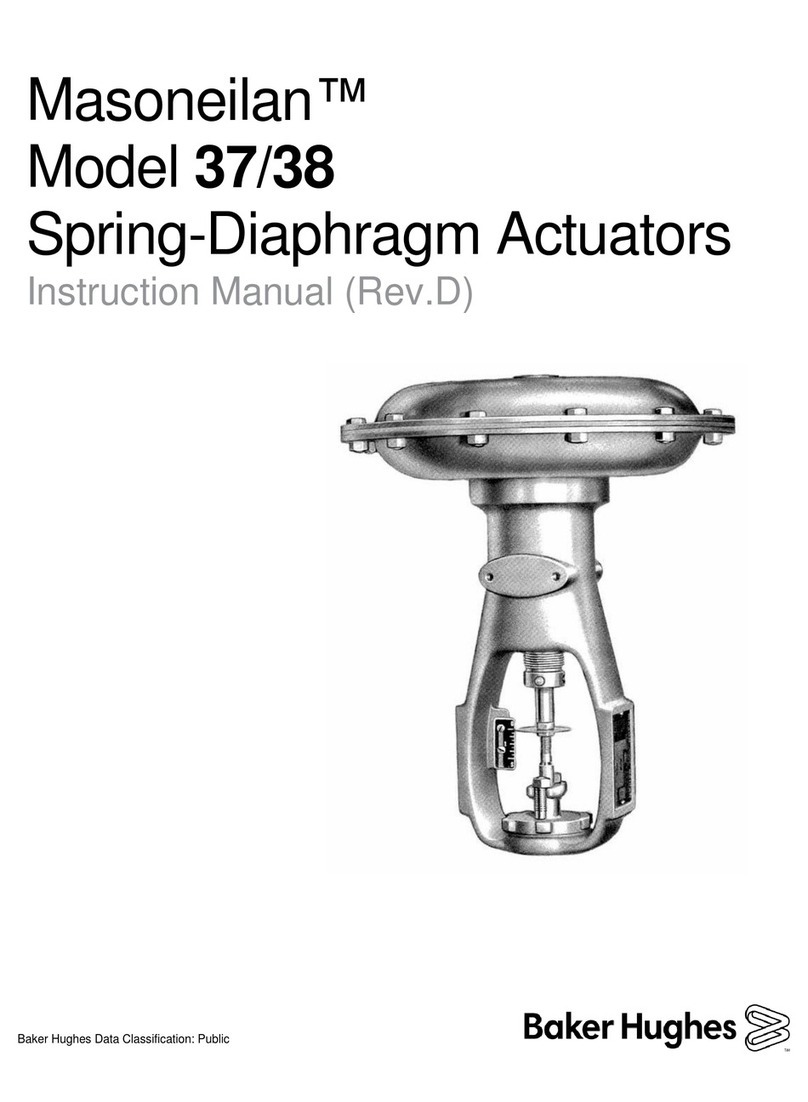
Baker Hughes
Baker Hughes Masoneilan 37 instruction manual
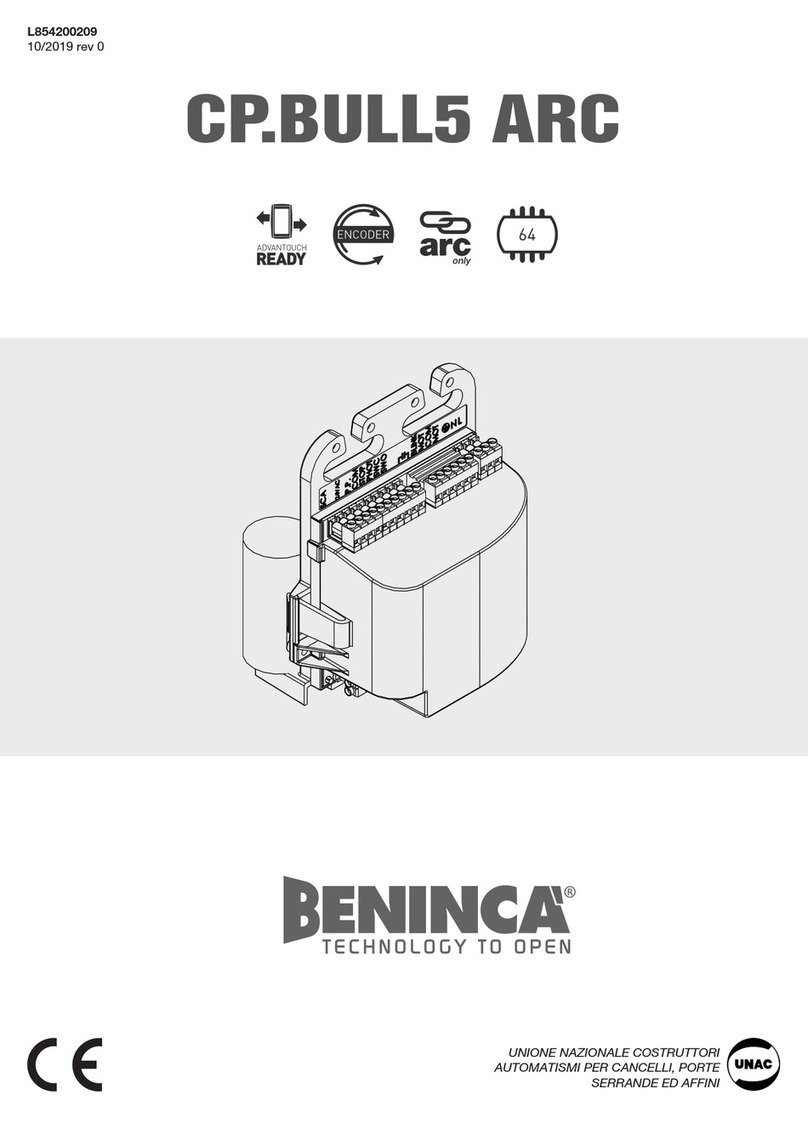
Beninca
Beninca CP.BULL5 ARC manual
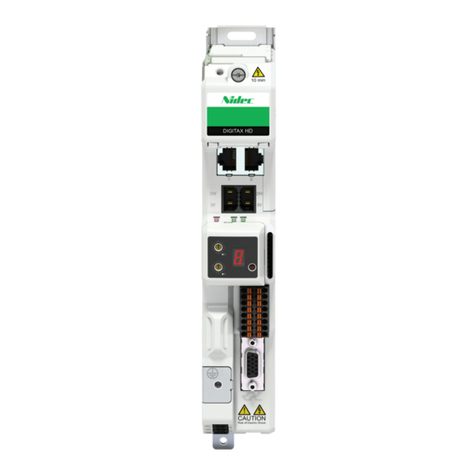
Nidec
Nidec Digitax HD M75X Series quick start guide
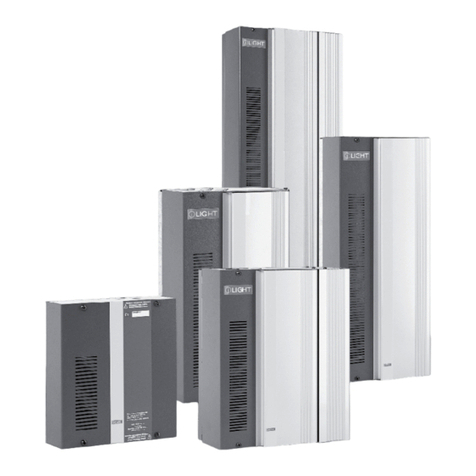
iLight
iLight SCI0405 instruction manual
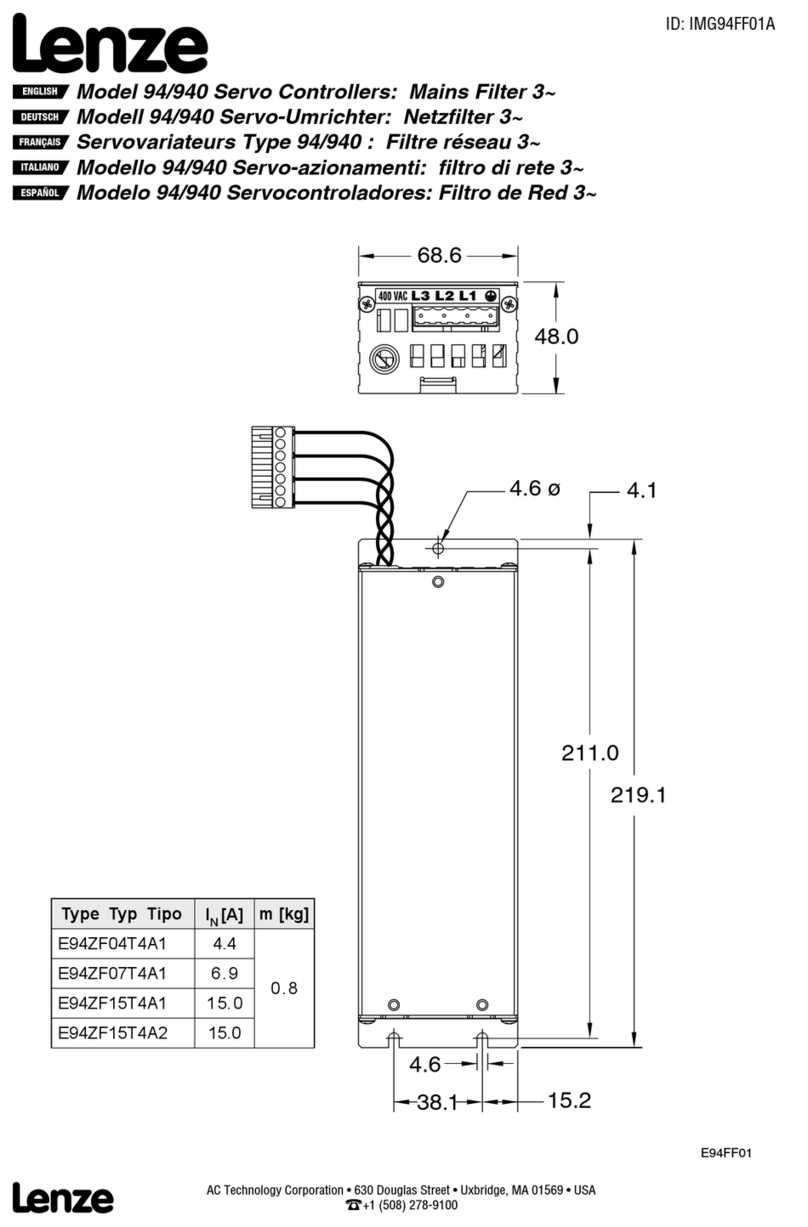
Lenze
Lenze 94/940 quick start guide
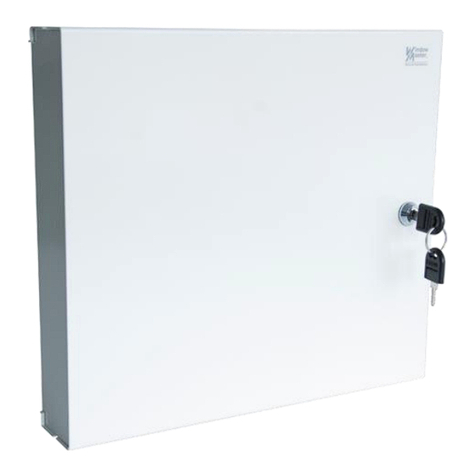
WindowMaster
WindowMaster MotorController WCC 310 UL Installation instructions manual

